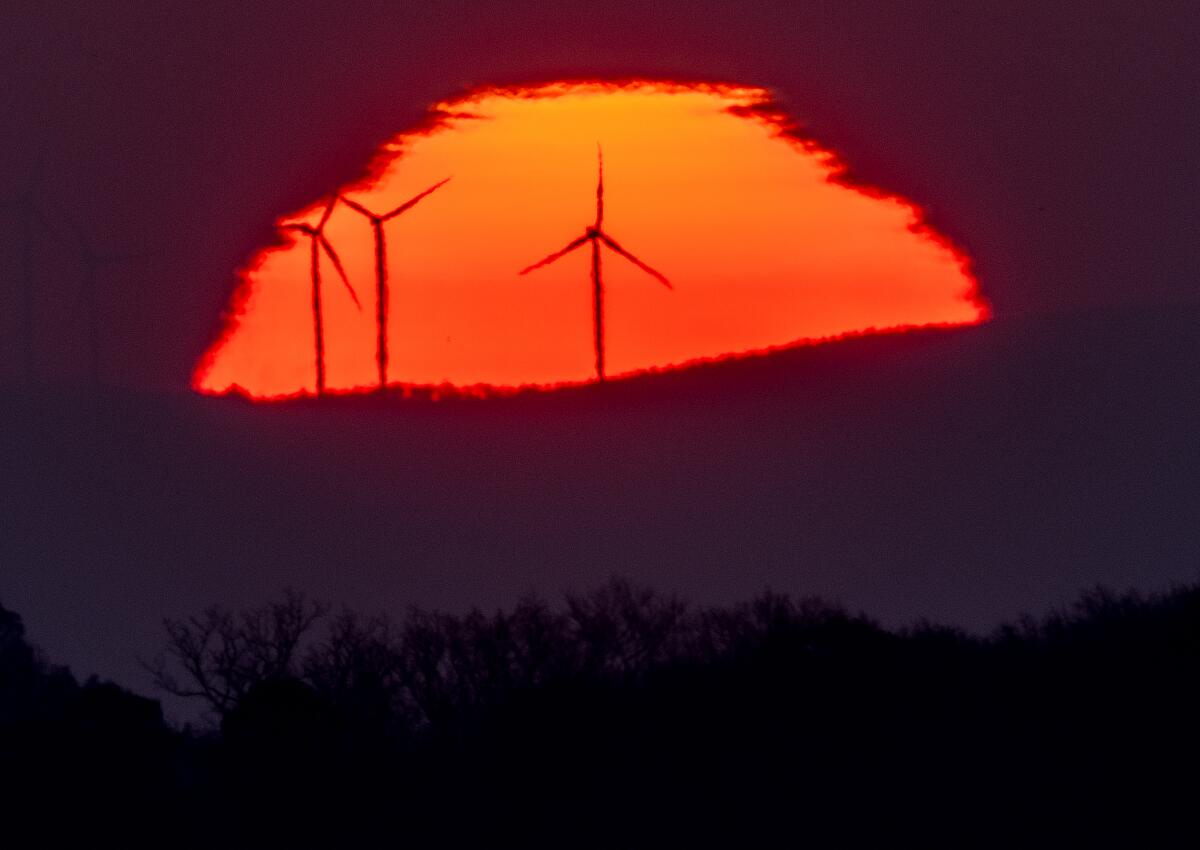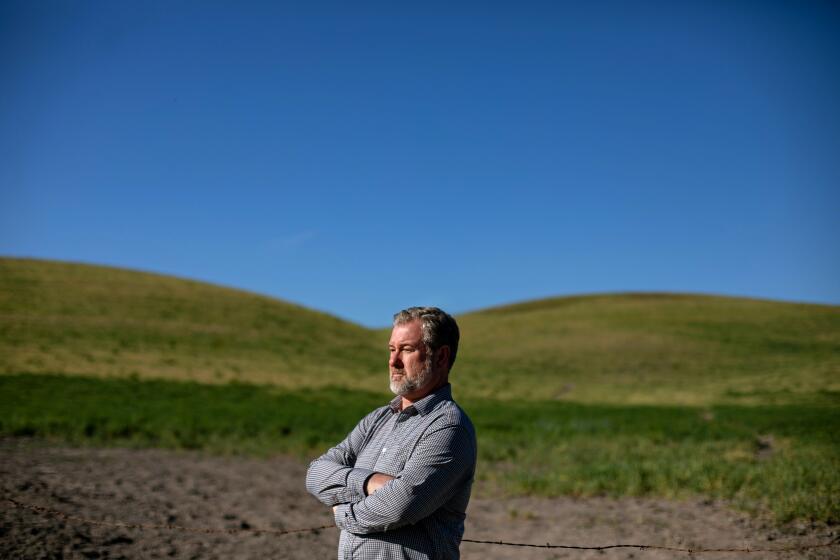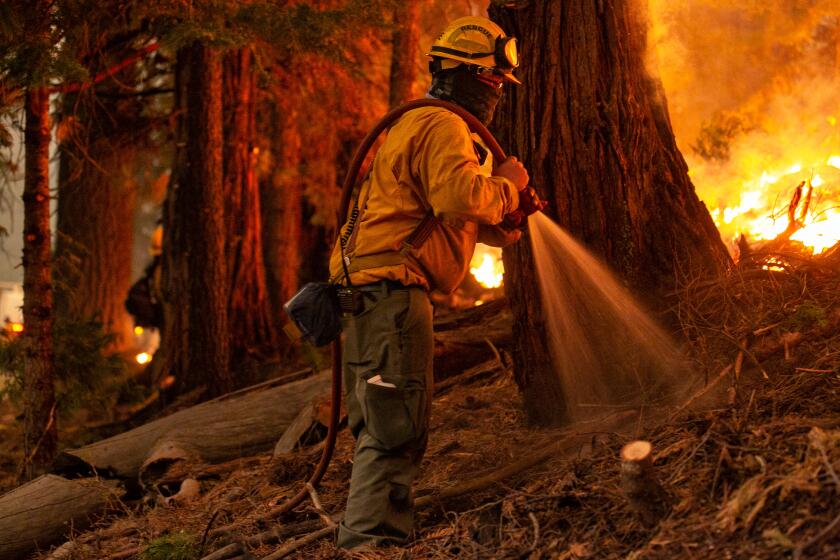Earth hurtling toward a dangerous temperature limit, major climate report warns

- Share via
BERLIN — Temperatures on Earth will shoot past a key danger point unless greenhouse gas emissions fall faster than countries have committed, the world’s top body of climate scientists said Monday, warning of the consequences of inaction but also noting hopeful signs of progress.
U.N. Secretary-General Antonio Guterres said the report by the Intergovernmental Panel on Climate Change revealed “a litany of broken climate promises” by governments and corporations, accusing them of stoking global warming by clinging to harmful fossil fuels.
“It is a file of shame, cataloguing the empty pledges that put us firmly on track towards an unlivable world,” he said.
Governments agreed in the 2015 Paris accord to keep global warming well below 2 degrees Celsius (3.6 degrees Fahrenheit) this century, ideally no more than 1.5 degrees Celsius (2.7 degrees Fahrenheit). Yet temperatures have already increased by over 1.1 degrees Celsius (2 degrees Fahrenheit) since pre-industrial times, resulting in measurable increases in disasters such as flash floods, prolonged droughts, more intense hurricanes and longer-burning wildfires, putting human lives in danger and costing governments hundreds of billions of dollars to confront.
“Projected global emissions from [national pledges] place limiting global warming to 1.5C beyond reach and make it harder after 2030 to limit warming to 2C,” the panel said.
In other words, the report’s co-chair, James Skea of Imperial College London, told the Associated Press: “If we continue acting as we are now, we’re not even going to limit warming to 2 degrees, never mind 1.5 degrees.”
Bouts of extreme precipitation, along with worsening drought and heat, are creating more of the dangerous dust, experts say.
Ongoing investments in fossil fuel infrastructure and clearing large swaths of forest for agriculture undermine the massive curbs in emissions needed to meet the Paris goal, the report found.
“To keep the 1.5-degree limit agreed in Paris within reach, we need to cut global emissions by 45% this decade,” said Guterres, the U.N. chief. “But current climate pledges would mean a 14% increase in emissions.”
In a summary negotiated with governments over the last two weeks, the panel concluded that returning warming to 1.5 degrees Celsius by 2100 would require removing vast amounts of carbon dioxide — the main greenhouse gas — from the atmosphere. Many experts say this is unfeasible with current technologies, and even if it could be done, it would be far costlier than preventing the emissions in the first place.
The report’s authors said they had “high confidence” that unless countries step up their efforts to cut greenhouse gas emissions, the planet will on average be 2.4 to 3.5 degrees Celsius (4.3 to 6.3 degrees Fahrenheit) warmer by the end of the century — a level experts say is sure to cause severe impacts for much of the world’s population.
“We are on a pathway to global warming of more than double the 1.5-degree limit agreed in Paris,” Guterres said. “Some government and business leaders are saying one thing — but doing another.”
“Simply put, they are lying,” he added. “And the results will be catastrophic.”
Despite the tough words by Guterres and report co-chairs, the full report, numbering thousands of pages but condensed into a summary by governments and scientists, doesn’t single out individual countries for blame.
However, the figures show much of the carbon dioxide already in the atmosphere was released by rich countries that were the first to burn coal, oil and gas when the industrial revolution really got going in the 1850s.
Toward a more sustainable California
Get Boiling Point, our newsletter exploring climate change, energy and the environment, and become part of the conversation — and the solution.
You may occasionally receive promotional content from the Los Angeles Times.
The U.N. panel said about 40% of emissions since then have come from Europe and North America. Just over 12% can be attributed to East Asia, which includes China. The country took over the position as world’s top emitter from the United States in the mid-2000s.
The report isn’t without some hope, however.
Its authors highlight myriad ways in which the world can be brought back on track to 2 degrees Celsius or even, with great effort, return to 1.5 degrees Celsius after that threshold has been passed. This could require measures such as the removal of CO2 from the atmosphere with natural or artificial means, but also potentially risky technologies such as pumping aerosols into the sky to reflect sunlight.
Among the solutions recommended are a rapid shift away from fossil fuels toward renewable energy such as solar and wind, the electrification of transport, more efficient use of resources and massive financial support for poor countries unable to pay for such measures without help.
One move often described as “low-hanging fruit” by scientists is to plug methane leaks from mines, wells and landfills that release the potent but short-lived greenhouse gas into the atmosphere. A pact forged between the United States and China at last year’s U.N. climate conference in Glasgow, Scotland, aims to do just that.
“You can see the first signs that the actions that people are taking are beginning to make a difference,” said Skea, the panel’s co-chair.
“The big message we’ve got [is that] human activities got us into this problem and human agency can actually get us out of it again,” he said.
The panel’s reports have become increasingly blunt since the first one was published in 1990, and the latest may be the last before the planet passes 1.5 degrees Celsius of warming, Skea told the AP.
Nine things you should know about Gov. Gavin Newsom’s budget proposal.
Last August, it said climate change caused by humans was “an established fact” and warned that some effects of global warming are already inevitable. In late February, the panel published a report that outlined how further temperature increases will multiply the risk of floods, storms, drought and heat waves worldwide.
Still, the British government’s former chief science advisor David King, who wasn’t involved in writing the report, said there are optimistic assumptions about how much CO2 the world can afford to emit.
The U.N. panel suggests there’s still a “carbon budget” of 500 billion metric tons (550 billion U.S. tons) that can be emitted before hitting the 1.5 degrees Celsius threshold.
“We don’t actually have a remaining carbon budget to burn,” said King, who now chairs the Climate Crisis Advisory Group.
“It’s just the reverse. We’ve already done too much in the way of putting greenhouse gases up there,” he said, arguing that the Intergovernmental Panel on Climate Change’s calculation omits new risks and potentially self-reinforcing effects already happening in some places, such as the increased absorption of heat into the oceans from sea ice loss and the release of methane as permafrost melts, he said.
Such warnings were echoed by U.N. chief Guterres, citing scientists’ warnings that the planet is moving “perilously close to tipping points that could lead to cascading and irreversible climate impacts.”
“But high-emitting governments and corporations are not just turning a blind eye; they are adding fuel to the flames,” he said, calling for an end to further coal, oil and gas extraction that the report said might have to be abandoned anyway, resulting in losses of trillions of dollars.
“Investing in new fossil fuels infrastructure is moral and economic madness,” said Guterres.
Vulnerable nations said the report showed big polluters have to step up their efforts.
“We are looking to the G-20, to the world’s biggest emitters, to set ambitious targets ahead of [climate change conference] COP27, and to reach those targets — by investing in renewables, cutting out coal and fossil fuel subsidies,” said Tina Stege, climate envoy for the Marshall Islands. “It’s long past time to deliver on promises made.”
More to Read
Toward a more sustainable California
Get Boiling Point, our newsletter exploring climate change, energy and the environment, and become part of the conversation — and the solution.
You may occasionally receive promotional content from the Los Angeles Times.












